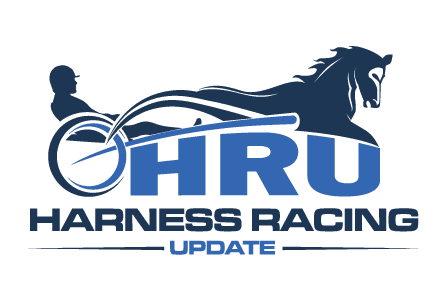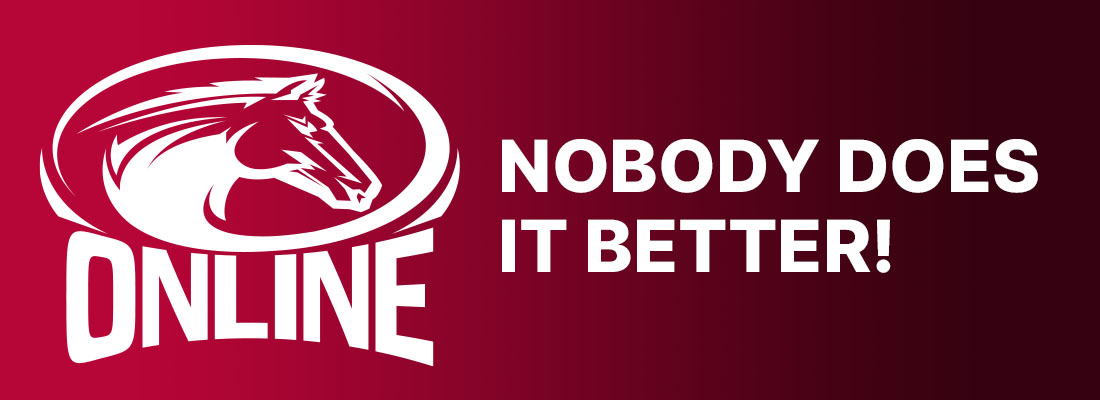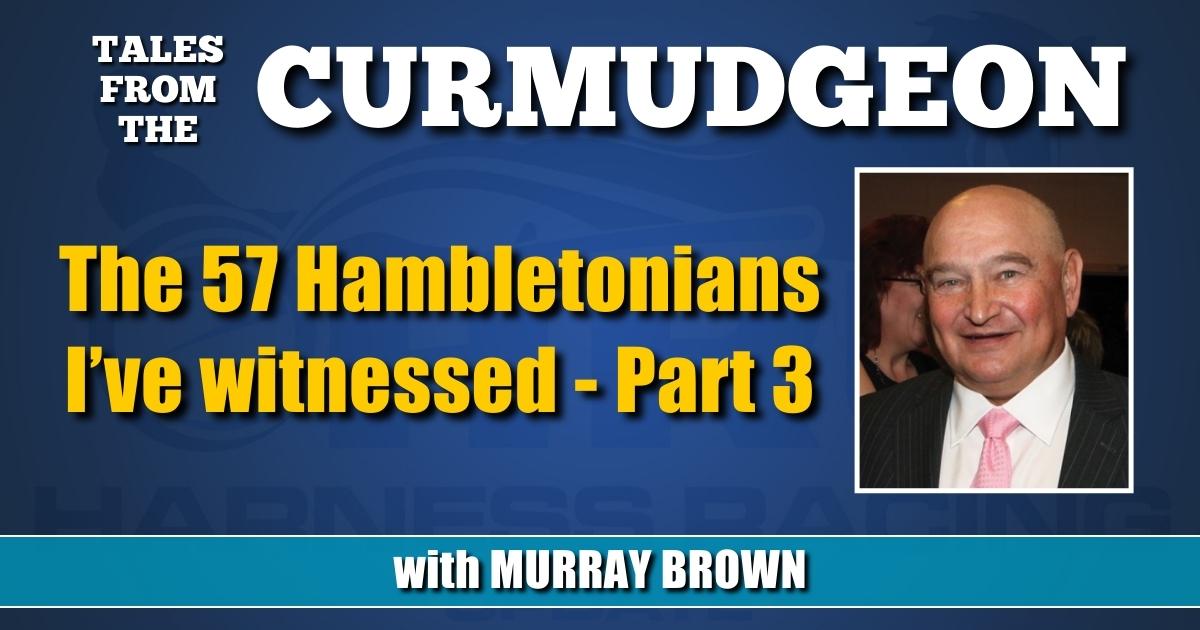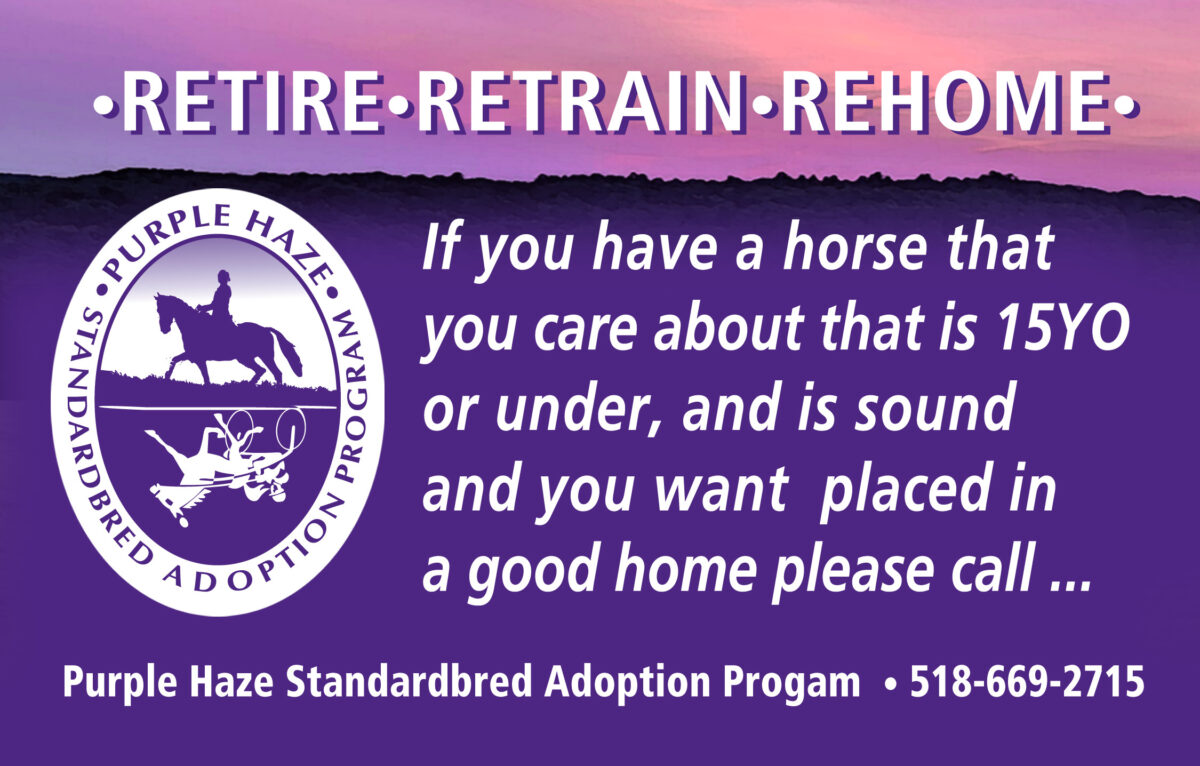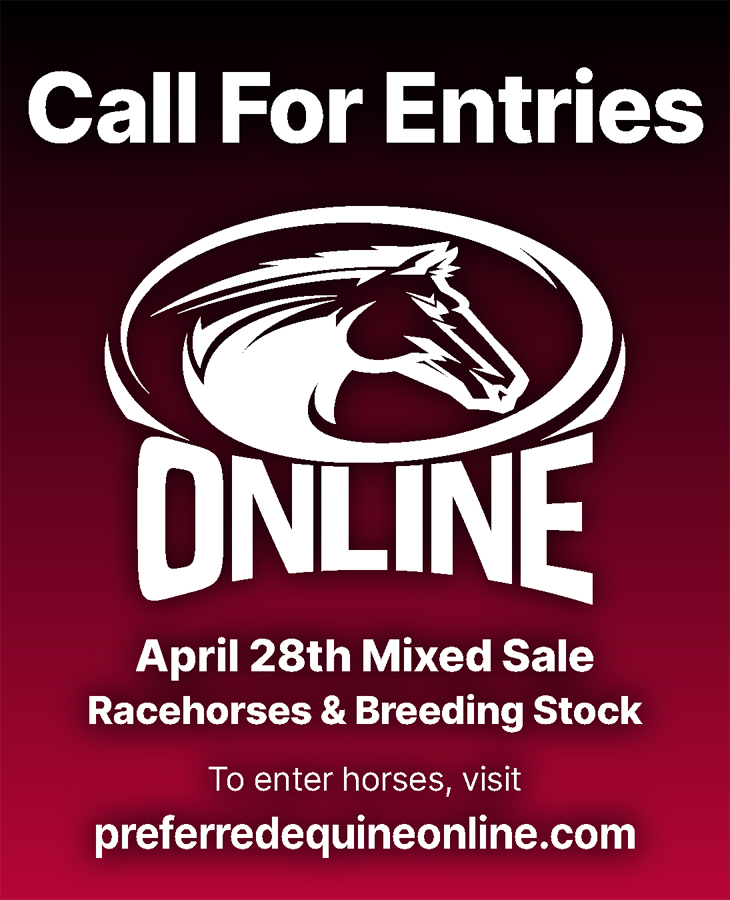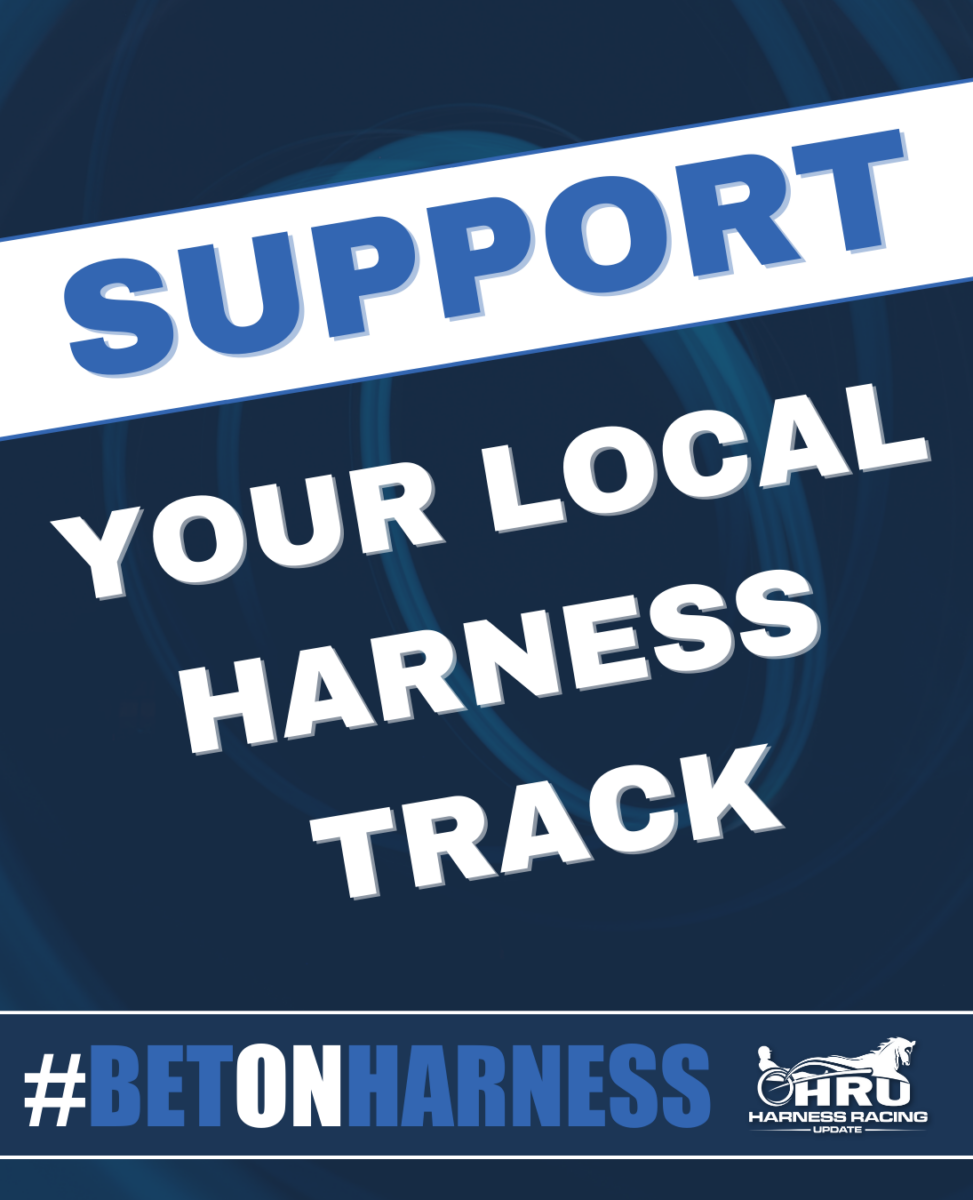The 57 Hambletonians I’ve witnessed
Part 3 — The Meadowlands in the 21st century.
by Murray Brown
Editor’s note: Two things to note about this column. By our count, this is the 200th column Murray Brown has written for HRU. Congratulations on the milestone Murray and thank you for your fine work over the years. Also, since Murray went all out for his 200th column and wrote a lengthy conclusion to his three-part series, we thought it appropriate to publish this one on Friday rather than Murray’s usual Sunday spot. Tales from The Curmudgeon will return to its usual Sunday spot as of the Sept. 3 edition.
Part 1 is here.
Part 2 is here.
2000 — Yankee Paco — The only chestnut in my 57 years at the race. The only other one that I remember was Blaze Hanover, winner of the 1960 race. Yankee Paco carried a significant Canadian connection through his trainer Doug McIntosh, driver Trevor Ritchie and sire Balanced Image (making Yankee Paco the first Canadian-sired Hambletonian winner). His breeder, Charlie Keller’s Yankeeland Farms, and his owners Harry and Dr. Tom Ivey completed the other two fifths of his background. He was a good, but not a great colt. Nevertheless, on the day when it counted most, he proved to be the best. The best of those in opposition was Credit Winner who was a fast closing second in the race and turned out to be the best of the class through season’s end. Credit Winner was destined to become the leading New York sire for the next two decades until Chapter Seven took over.
2001— Scarlet Knight — Another sweep for Sweden. All three eliminations — Scarlet Knight (Stefan Melander), Victory Sam (Jimmy Takter) and Cigar Man (Berndt Lindstedt) — were won by Swedish natives, with Scarlet Knight winning the race for Melander. In November of 1999 Swedish horseman Melander came to Harrisburg looking to buy some yearlings. Among those he purchased was Hip No. 126 a relatively unimpressive Pine Chip colt from the Perretti Farms consignment for a price of $17,000. How did I know that he was unimpressive? I asked Perretti’s Bob Marks about him. Marks did not remember him as a yearling, which meant that he neither was very good or very bad, otherwise he would have been remembered. Another clue was his price. Perretti Farms was not in the habit of selling yearlings — especially trotters which they thought highly of — in that low price range. If they thought highly of him, he would have been made to bring more. One clue though to his being a very good horse was at the 2001 January sale at The Meadowlands. Melander met Marks and told him that he had bought a colt from Perretti two Novembers previous that he thought highly of. He said the next time he saw him would be at that summer’s Hambletonian. Melander, back then and to some degree even today, was perhaps better known as the best equine photographer in Sweden, known as Foto Tarzan. Most, including myself had not remembered that this win did not represent his first trip to the United States to compete in a top race. In 1995, he was invited to New York to compete in the International Trot at Yonkers Raceway. He was also victorious there with the Swedish-bred His Majesty S, a son of Ideale de Gazeau. Melander brought Scarlet Knight to The Meadowlands with eight straight wins on his dossier and in effect toyed with his opposition.
2002 — Chip Chip Hooray — The overwhelming favorite entering the race was the previous year›s 2-year-old champion Andover Hall. As usual for that time, the Erkki Laakkonen owned, Bob Stewart trained colt was driven by John Campbell. Early in the race Likely Lad and Berndt Lindtstedt backed into Andover Hall causing him to go on a break. Where were the judges? Not even an inquiry. The overwhelming chalk makes a break in close quarters and there is not even an inquiry? Chip Chip Hooray was around to pick up the pieces. Taurus Dream cut very fast fractions for the era, taking no prisoners. He was caught near the top of the lane by Chip Chip Hooray who was able to stave off a fast closing Like A Prayer.
2003 — Amigo Hall — Another Canadian-invading son of Balanced Image. Trained by his part owner Blair Burgess and driven to his fourth Hambletonian win by Mike Lachance. A good horse but not a top one; but neither was his competition. Prior to starting him in the big race, Amigo Hall had been driven in his last two races in Ontario Sires Stakes by Trevor Ritchie. He was just okay but apparently was having a bit of trouble on the turns. Burgess thought that the turns and surface at The Meadowlands might please him more. Ritchie couldn’t get down for the qualifier, so Burgess put Lachance down to drive. He apparently raced well and Burgess asked Lachance if he thought he should enter him in the big dance. The answer was an unenthusiastic yes. Burgess entered him putting Ritchie down to drive. Ritchie instead chose Bob Stewart’s colt. For his elimination, John Campbell was available since the horse he was pledged to was in another elimination. Amigo Hall finished third for Campbell. As he was leaving the paddock, Burgess encountered Lachance. “You need a driver for next week” Lachance said. “No, I don’t” Burgess said “You’re driving him.” Burgess thought that Lachance suited his colt well. Amigo Hall could leave and that is what Lachance liked to do. Moreover, Lachance knew his horse. The rest is history.
2004 — Windsong’s Legacy — The first Trotting Triple Crown winner since Super Bowl in 1972 and Trond Smedshammer, the first trainer/driver to win the race since Stanley Dancer with Duenna in 1983. Probably a great trotter, for sure a very good one. I’m guessing that his son Chapter Seven and that horse’s exceptional success at stud will keep his light shining forever. But Windsong’s Legacy was not only a terrific racehorse, but he was also a great sire who’s light was extinguished far too early by his early death at 7 years of age after only three full years at stud. In my view only an ill-conceived idea to skip the Breeders Crown prevented him from becoming the 2004 Horse of the Year. The one thing that remains in my mind’s eye following his Hambletonian victory was the sight of his breeder Pete Spears walking from the outside of the winner’s enclosure clutching a stack of win tickets that he had wagered on his boy.
2005 — Vivid Photo — In my mind the result of this race was a picture of the country boy outslicking the city slickers. When speaking of harness racing, Roger Hammer is referred to as the “King of the Fairs.” If one were looking for an entry, Hammer would be No. 1 and his good friend Todd Schadel would be No. 1A. Hammer and Schadel had been buying yearlings, mostly at Harrisburg, but sometimes elsewhere and occasionally raising some themselves. They were at the Harrisburg Sale in 2003 and decided to pool their resources on a few yearlings. Among their purchases was Hip No. 853, an S Js Photo colt named Vivid Photo selling on the last day of the sale. At the time $30,000 was usually a little out of their individual price range. But heck, they were buying the colt together, so the freight would only be $15,000 each. Hammer would train and race the colt. The plan initially was to race him in Pennsylvania at the fairs and maybe try the sire stakes if he was good enough. If maybe someone thought he was worth more than they did, they might sell him. The partners didn’t foresee any stud potential in their fiery colt so he was gelded. They kept him eligible to most of the local stakes and because Hammer thought that he might have been special they decided to keep him eligible to a few Grand Circuit Stakes including the Hambletonian. At 2, he only raced six times, his racing restricted to the fair circuit. Hammer thought he had the makings of a good horse. He entered the Hambletonian as the winner of four overnights and four minor stakes. There were many who questioned this “country” horse taking on the best in North America. In his first heat, he went first over after leaving the gate and hung on to win by a neck in 1:53.2. In the race final Hammer fooled everybody. After all, Hammer almost always leaves. Vivid Photo does for sure. He had left in 10 of his previous 11 races. Hammer took back and watched the race with a big smile on his face. When Hammer said go, Vivid Photo went, going by the field and winning the race in 1:52.3. Vivid Photo finished the year earning $1,376,829 and being voted the Dan Patch 3-Year-Old Male Trotter of 2005. He retired at 10 with lifetime earnings of $3,273,387.
2006 — Glidemaster — Another of Blair Burgess› bargain champions. He was plucked from the ٢٠٠٤ Lexington Sale for the ridiculously low price of $١٠,٠٠٠. He was a big plain colt, apparently much like his dam Cressida Hanover was as a yearling. I remember her distinctly, not because she was beautiful, but because she was anything but. Using a single word, I might say she was ugly. She was a big, plain filly who looked anything but athletic. I remember a conversation with Dr. J after the sale; both us being surprised that as astute a horseman as Ronnie Gurfein bought her for any price, even though she brought only $13,000. She ended up getting to the racetrack, although her earnings were minimal and she failed to get a record. Glidemaster exhibited extra special talent at 2, before in effect having a nervous breakdown at Lexington. Burgess showed the great horsemanship with which he has been blessed and wisely stopped with him immediately. At 3, Burgess took him to school from the beginning. He emerged as a new horse from the colt that some feared might be ruined. He not only won the Triple Crown, but he finished the season with earnings of $1,903,023 and was Trotter of the Year enroute to gaining driver John Campbell his sixth record setting Hambletonian win. There are two horses — Muscle Hill being the other — who I believe should have raced at least another year and gone to Europe to take on the best there in the Prix d’Amerique and Elitloppet. There is no doubt in my mind that both would have done well there. I have actually discussed this with Burgess. He agreed, however practical needs including financial matters relating to the syndication of the horse won out.
2007 — Donato Hanover — Another great horse. Both the 2- and 3-Year-Old Male Trotter of the Year in each of the years that he raced. Donato Hanover represented the biggest mistake I made in my 65-year involvement in the sport. As a yearling I absolutely loved him. He wasn’t the one generally considered the best yearling we had that year, but was among the best. He was definitely my number one pick. He brought $90,000. He was bought by David Scharf, to be owned by a partnership group he was putting together and trained by Steve Elliott, both good friends. There is absolutely no doubt that if I had wanted in as a partner, I would have been welcomed. It wasn’t as though I couldn’t afford to buy in. I am by no means a wealthy person but at that junction in my life, all of my kids had graduated from college. I had no financial restraints. I could have afforded at least a 10 per cent investment. But for some still unknown reason I didn’t buy in. Proof of my stupidity was that the next year when the horse was being syndicated for six million dollars, I bought a single share representing 1/60th for $50,000 more than five times what it would have cost me to buy 10 per cent the previous year. The win was the second Hambletonian steer for Ronnie Pierce and the first training victory for Elliott.
2008 — Deweycheatumnhowe — Bred and raised at Steve Jones›s Cameo Hills Farm. Dewey was purchased for $٨٠,٠٠٠ by his good friend Ray Schnittker from the Lexington Selected Yearling Sale. As Schnittker has been sometimes known to say, “When buying yearlings, we don’t know what we are doing. It’s all a crapshoot. So, we might as well be buying from our friends rather than from those who are not.” He was very impressive early at 2, syndicated by Alan Leavitt and turned out shortly thereafter to prepare for the major 3-year-old wars. He entered the Hambletonian as the undefeated favorite and exited the same way as the winner of trotting’s greatest event. He was the first to win the race wearing trotting hobbles.
2009 — Muscle Hill — Trained by Greg Peck and driven by Brian Sears, it was the first Hambletonian win for each. In my view, not only the greatest Hambletonian winner ever, but also the greatest trotter on which these eyes were ever focused. He entered the race undefeated, but for an early race at 2, where he was just learning what racing was all about. From that point forward he was undefeated, make that unchallenged. So great was his talent that he never competed where he was “all out.” The sport was robbed of its greatest trotter ever by his early retirement at 3. Here’s a tidbit that some might not be aware of. There was a deal in place for the horse to be purchased by Bill Perretti to stand at his Perretti Farms. Before the deal was consummated, Perretti, as he was sometimes known to do, changed his mind and Muscle Hill instead went to Southwind Farms where he became and still is one of harness racing’s greatest sires.
2010 — Muscle Massive — Muscle Massive may not have even been the best horse on the day. It was a battle between two very good horses and two of the greatest driving geniuses that our sport has been privileged to possess. On this day, longshot Muscle Massive was to emerge victorious over favorite Lucky Chucky and Ronnie Pierce came out ahead of John Campbell. From my viewpoint, neither horse was to again excel on the big stage for the remainder of their careers.
2011 — Broad Bahn — One of those that I sometimes perhaps unfairly refer to as «One Hit Wonders.” In an interview I had with trainer Noel Daley some time back, he referred to Broad Bahn as certainly not being a great horse, but one that he felt fairly confident with his chances on entering the race that day. I didn’t ask him why. I guess I should have. He defeated a pretty decent field that included Chapter Seven, Manofmanymissions and Whiskey Tax. He was Daley’s first win in the race as well as that for driver George Brennan.
2012 — Market Share — One of numerous quality horses picked for clients by horse agent Pat Waldo. Market Share was purchased as a yearling for $18,000. Among his other great “picks” for clients were Valley Victory for $60,000, Chapter Seven for $42,000 and Hambletonian winner Harmonious for $25,000. Entering the race, Market Share was fourth choice for trainer Linda Toscano and driver Tim Tetrick. The first Hambletonian for each. It was a good field which included pre-race favorite Uncle Peter, Archangel, Guccio and My MVP. Although Market Share was a colt, he was for all intents a gelding, which he now actuality is. His testicles were very small, and thus contributed to rendering him infertile.
2013 — Royalty For Life — One of those that was the best on this day. The three elimination heat winners were Royalty For Life, Creatine and Spider Blue Chip. Royalty For Life was a decisive gate-to-wire winner for driver Brian Sears for his second Hambletonian victory and for New England horseman, George Ducharme, his first.
2014 — Trixton — Going into the race the 2-5 favorite Father Patrick was considered a lock by just about everyone. However as sometimes has been known to happen in racing and especially the Hambletonian, the favorite did not cooperate. Leaving from the outside 10-hole Father Patrick made a break at the start and was out of contention. Nuncio went one heck of a race, cutting the mile and being pressured most of the way. He tried as hard as a horse can try, but was unable to hold off Trixton at the wire with trainer Jimmy Takter at the lines. Both Trixton and Nuncio as well as the vanquished Father Patrick were members of the Takter stable. In addition, the Takter trained Lifetime Pursuit was victorious in the Hambletonian Oaks that day.
2015 — Pinkman — A return to the Hambletonian winner’s circle for the Takter stable for their third win. The same for driver Brian Sears for his third. The two elimination heats had been won by Yannick Gingras driven horses, the spectacular filly Mission Brief and the gelding Pinkman. Gingras had to make a choice for the final. He chose the filly and finished second. Sears drove Pinkman. Trainer Ron Burke has described that loss as the biggest disappointment of his career. Pinkman won the final in gate-to-wire fashion winning by three quarters of a length over Mission Brief.
2016 — Marion Marauder — This was a Canadian influenced Hambletonian. Both the trainer Paula Wellwood and the driver Scott Zeron, each Canadian, were making their first start in the race. Both the heat winners — Bar Hopping and Marion Marauder — were sons of super sire Muscle Hill. The winter favorite for the race had been Southwind Frank, another son of Muscle Hill. The final was won by Marion Marauder, by a nose over Southwind Frank. Misfortune in the breeding arena was to follow these three colts. Marion Marauder was deemed to be infertile and was gelded. He is now a distinguished representative of harness racing at the Kentucky Horse Park. Bar Hopping was considered a marginal breeder, but with proper management, he was able to handle normal books of mares at Hanover. Then tragedy struck. Before the beginning of the past breeding season, he died. Southwind Frank also was considered to be a problematic breeder and is only able to handle small books. He nevertheless does well considering the paucity of quality mares he receives.
2017 — Perfect Spirit — This was one of the most controversial Hambletonians ever. The first elimination was won by the Antonacci owned, bred and raised International Moni; trained by young Frank M. Antonacci and driven by Scott Zeron. The second elimination was won by the Marcus Melander trained and Tim Tetrick driven Enterprise. It was in the final that the fireworks went off. At the start International Moni, was obviously interfered with and made a break, knocking him out of contention. Once again, not even an inquiry. Near the end of the race longshot What The Hill was ruled to have interfered with Guardian Angel AS causing that horse to make a break. He was placed from first to last. Swedish owned Perfect Spirit trained and driven by Ake Svanstedt was ruled the winner of the race. The ruling was appealed but ultimately upheld.
2018 — Atlanta — The first filly to win the race since Continentalvictory in ١٩٩٦. Trainer and part owner Rick Zeron had bought Atlanta as a yearling at Harrisburg for $60,000. She showed speed but was making breaks at 2. At 3, she came into her own. After winning the Empire Breeders Trot with her, Scott Zeron told his dad that he had his Hambletonian horse. He was correct. In the first heat, Scott said that he had miss-rated her speed and just got nipped at the wire. He won the final in gate-to-wire fashion in a perfectly rated mile. She retired last year with lifetime earnings of $3,533,707.
2019 — Forbidden Trade — An all-Canadian triumph. His trainer, driver, owner and her sire come from Canada. Although her breeder Steve Stewart, the man who raised him, comes from the Bluegrass State of Kentucky. He was purchased by Serge Godin’s Determination Stable at Harrisburg for $110,000. He was a nice 2-year-old, but just that. He started to bloom at 3, but there were those that doubted his chances in the Hambletonian. This was a power packed field which included the likes of 1-5 favorite Greenshoe, Gimpanzee, Green Manalishi and Marseille. But this was to be Forbidden Trade’s Day. The eliminations were won by Greenshoe and Green Manalishi. In the final Bob McClure worked out a good trip after being on the rim for some time. He seemed to have track announcer Ken Warkentin fooled. It appeared that Warkentin was about to call Greenshoe the race winner, but switched to Forbidden Trade at the very end.
2020 — Ramona Hill — The second filly in three years to win America’s Classic Trotting Race. I have watched the replay of her elimination of the race innumerable times and still scratch my head in wonder how driver Andrew MacCarthy managed to win from where he was as late as the three quarters. He took a more conventional manner with a comfortable win in the final. It was the first Hambletonian win for trainer Tony Alagna and the ownership group which consisted of Brad Grant, Crawford Farms, Robert Leblanc and In The Gym Partners. She is now a broodmare jointly owned by Hanover Shoe Farms and Crawford Farms. Her first foal is a suckling filly by Walner and she is back in foal to that stallion.
2021 — Captain Corey — An anomaly, Captain Corey is by a stallion Googoo Gaagaa who was bred to be a pacer, but was a trotter and a very good trotter. Googoo Gaagaa was raced in this country and showed incredible ability, but his owner could not find a farm in America who he felt would support him to the degree that he deserved. So, he was sent to Sweden where he has been a sensational success, to the extent that he is now one of the leading trotting stallions in Europe. In his Hambletonian, Captain Corey wired the field from beginning to end cutting vicious fractions. He is now a stallion standing at Hanover Shoe Farms where he served full books in his first two seasons at stud.
2022 — Cool Papa Bell — The horse›s namesake, a great player in the Negro Baseball League, was inducted into the Baseball Hall of Fame in 1974. The horse, a decided longshot in the Hambletonian came from well off the pace to win a second Hambletonian for trainer Jim Campbell and the first for young Aussie driver Todd MacCarthy. The favorites for the race, Rebuff and Jiggy Jog S battled it out while Cool Papa Bell bided his time waiting for the waters to part. They did and Cool Papa Bell won the Hambletonian at odds of 52-1.
2023 — Tactical Approach — Early in the season this colt appeared to be one of the better trotters in his class. However, as the season reached its midway point he hadn’t raced much. What little racing he had done had been okay, but not jaw opening. Trainer Nancy Takter entered him hoping to at the very least get a good chunk of the purse, but even that might be difficult since he had drawn the outside 10-hole. Early speed had not been holding up all day. Driver Scott Zeron took a seat following horses hoping that they’d go right while he stayed straight. That is exactly what happened and he won his third Hambletonian and trainer Nancy Takter earned her first for owners Robert Leblanc, John Fielding, John Fodera, Joe Sbrocco and JAF Racing.
Note: I was having a discussion with a friend on how many have been to all the Hambletonians held at The Meadowlands. The over/under number we came up with was 10. Those that I know that have been to all of them are John Campbell, Bob Boni and myself. Some notable “all but one” attendees are Tom Charters and Bob “Hollywood” Heyden (who was in the hospital for one), and Ray Remmen in Western Canada for a previous engagement for the second time. If you have been to all of them, please let me know through my email address at the end of the story. I will make sure you are acknowledged next week.
Have a question or comment for The Curmudgeon? Reach him by email at: hofmurray@aol.com
